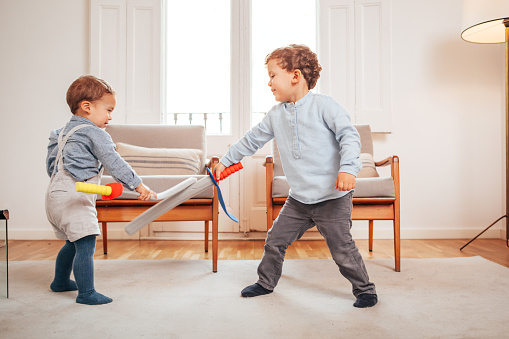
With so many violent tragedies playing out in our schools and communities, parents are understandably concerned when their children have pretend play with violent themes. I often have parents come to me with concerns over pretend gun play in particular.
Developmentally, this play has a very important function. Your child is learning to manage, contain and control their aggressive impulses. Everyone has these impulses. We all get angry, jealous or afraid. We all have the desire, conscious or unconscious, to lash out and hurt someone. Play gives children the opportunity to explore and work through these feelings without actually hurting anyone. Children who act out these feeling through play have less need to do so in ‘real life.’ While you find this play disturbing, it actually is helpful to your long-term goal of raising a peaceful, non-violent young adult.
Case Study
A few years back, a family sought my help because their 4-year-old son was very aggressive. On trips to the playground, the boy would walk over and hit another child on the head, apparently without any provocation. Nothing the parents had tried—reasoning, scolding, times outs—had been effective. They were embarrassed by the behavior and worried about their son’s future. I asked the parents to play with their son in my office while I observed. As they played with their son, the parents were warm, loving and engaged, but whenever his play veered to symbolic violence, they steered the play in another direction. Within a few minutes, I understood the crux of the problem. The boy was being thwarted in his attempts to act out his aggression symbolically, so he was doing it physically. I worked with the parents and helped them to respond to the child’s play in a supportive, non-judgmental manner. As the child was able to communicate about his feelings with his parents through play and receive a loving, non-judgmental response, the aggressive behavior disappeared.
Addressing Gun Play
Many parents feel more comfortable with sword play than guns. This is more true than ever given the epidemic in gun violence we are experiencing here in the US. Real swords are much less dangerous than real guns, and we are not experiencing a rash of sword violence in our communities. Pretend sword fights are less likely to trigger a negative responses in adults. On the other hand, pretend gun play is much less dangerous than pretend sword play.* When children are having pretend gun battles, they are standing several feet apart and pointing their fingers at one another. When children are having pretend sword fights, they are standing close together pointing long sticks or pieces of plastic at each other. To solve this problem, I recommend a foam pool noodle cut in two. This makes two really good swords (or light sabers for SciFi fans). Other great props for aggressive play are Nerf guns that shoot foam ‘bullets’ when squeezed, rolled up socks or cotton balls. All of these toys can be aimed and thrown hard at each other without causing injury. (Although, extended battles often cause a lot of giggling). For children who want to be lords of their own world, miniature dinosaurs, wild animals, knights and pirates are great props for acting out aggressive fantasies.
*I want to note that this is not always true when playing with realistic toy guns in public places, especially for children of color. For this reason, the toys that cannot be mistaken for guns are best. The index finger and thumb remain my favorite.
Gender and Violent Play
Most parents asking for advice on violent play are discussing boys. It’s important to note that acting out aggressive impulses through play is equally important for girls. Although less likely to become physically violent, girls who have trouble managing their aggression may become social bullies. Violent play in girls is often more subtle and may go unnoticed by parents because it does not involve guns and battles. Girls are more likely to spend their time mixing up poisons, protecting themselves and their young from monsters and placing their babysitters in jail “for the rest of your life.” Even so, girls should have access to props for aggressive play. The toy guns and canons in my office get used more frequently and enthusiastically by girls than by boys, perhaps because they have less access to them at home.
Summing It Up
I hope that by understanding the need for this play, it will become less troublesome to parents. If you can respond to your kids with empathy and without judgement when they engage in this play, it is more likely to stay in the symbolic realm. If ‘bang-bang’ sounds continue to bother you, limit them in a way that gives you respite without giving them the message that this play is wrong. ‘No guns in the house’ is an acceptable rule if there are other opportunities for your child to work through this aggression.
Remember that by playing with toy guns and pretend battles, your child is working on the same goal you have: to become an adult in control of, rather than controlled by, their aggressive impulses.
Where to Go From Here
Interested in learning more about the purpose and meaning behind you child’s play? Want to know how play can be used to improve communication parent/ child communication? Check out my four-week course, Know Your Child.

Want to read more like this?
Get notified when we post more helpful articles!